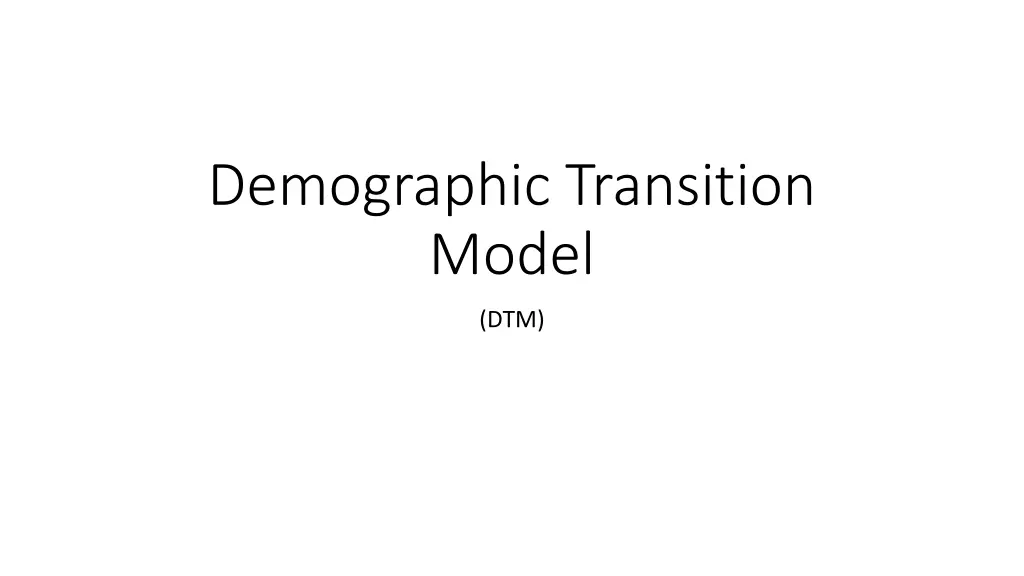
Understanding the Demographic Transition Model
Explore the Demographic Transition Model (DTM) through its stages - from high mortality and fertility to lower rates - as developed by Warren Thompson and Frank Notestein. Learn about the classic stages, causes, and characteristics of each phase, from the high fluctuating Stage 1 to the late expanding Stage 3. Understand how socio-economic progress influences demographic shifts.
Download Presentation

Please find below an Image/Link to download the presentation.
The content on the website is provided AS IS for your information and personal use only. It may not be sold, licensed, or shared on other websites without obtaining consent from the author. If you encounter any issues during the download, it is possible that the publisher has removed the file from their server.
You are allowed to download the files provided on this website for personal or commercial use, subject to the condition that they are used lawfully. All files are the property of their respective owners.
The content on the website is provided AS IS for your information and personal use only. It may not be sold, licensed, or shared on other websites without obtaining consent from the author.
E N D
Presentation Transcript
Demographic Transition Model (DTM)
What is the Demographic Transition? The shift from high to low mortality and fertility through four distinct stages. Based on the experience of Western Europe s Industrial Age. Began by Warren Thompson in 1929. Further developed in 1945 by Frank Notestein A sign of socio-economic progress?
The Classic Demographic Transition Stage 1 Stage 2 Stage 3 Stage 4 Birth rate Natural increase Death rate Time Note: Natural increase is produced from the excess of births over deaths.
Stage 1 - High Fluctuating Reasons Birth Rate is high as a result of: Lack of family planning High Infant Mortality Rate: putting babies in the 'bank' Need for workers in agriculture Religious beliefs Children as economic assets Death Rate is high because of: High levels of disease Famine Lack of clean water and sanitation Lack of health care War Competition for food from predators such as rats Lack of education Typical of Britain in the 18th century and the Least Economically Developed Countries (LEDC's) today. Crude Birth Rate: High 40-50 / 1,000 Crude Death Rate: High 40-50 / 1,000 Natural Increase Rate: None 0 / 1,000 Today, no country in the world is in Stage 1.
Stage 2 - Early Expanding Reasons Death Rate is falling as a result of: Improved health care (e.g. Smallpox Vaccine) Improved Hygiene (Water for drinking boiled) Improved sanitation Improved food production and storage Improved transport for food Decreased Infant Mortality Rates Typical of Britain in 19th century; Bangladesh; Nigeria Crude Birth Rate: High 40+ / 1,000 Crude Death Rate: Lower 15 / 1,000 Natural Increase Rate: Very High 25+/1,000
Stage 3 - Late Expanding Reasons Family planning available Lower Infant Mortality Rate Increased mechanization reduces need for workers Increased standard of living Changing status of women Typical of Britain in late 19th and early 20th century; China; Brazil. Crude Birth Rate: Lower 1,000 Crude Death Rate: Low 10 / 1,000 Natural Increase Rate: Low 10 / 1000 20 /
Stage 4 - Low Fluctuating Reasons Economy is settled Fully developed Middle Class Political stability Typical of USA; Sweden; Japan; Britain Crude Birth Rate: Low 1,000 Crude Death Rate: Low 1,000 Natural Increase Rate: None 0 / 1,000 10 / 10 /
Is the model universally applicable? Like all models, the demographic transition model has its limitations. It failed to consider, or to predict, several factors and events: 1 Birth rates in several MEDCs have fallen below death rates (Germany, Sweden). This has caused, for the first time, a population decline which suggests that perhaps the model should have a fifth stage added to it. 2 The model assumes that in time all countries pass through the same four stages. It now seems unlikely, however, that many LEDCs, especially in Africa, will ever become industrialized.
Continued 3 The model assumes that the fall in the death rate in Stage 2 was the consequence of industrialization. Initially, the death rate in many British cities rose, due to the insanitary conditions which resulted from rapid urban growth, and it only began to fall after advances were made in medicine. The delayed fall in the death rate in many developing countries has been due mainly to their inability to afford medical facilities. In many countries, the fall in the birth rate in Stage 3 has been less rapid than the model suggests due to religious and/or political opposition to birth control (Brazil), whereas the fall was much more rapid, and came earlier, in China following the government-introduced one child policy. The timescale of the model, especially in several South-east Asian countries such as Hong Kong and Malaysia, is being squashed as they develop at a much faster rate than did the early industrialized countries. 4 Countries that grew as a consequence of emigration from Europe (USA, Canada, Australia) did not pass through the early stages of the model.

![❤[READ]❤ Deep Space Craft: An Overview of Interplanetary Flight (Springer Praxis](/thumb/21511/read-deep-space-craft-an-overview-of-interplanetary-flight-springer-praxis.jpg)




















